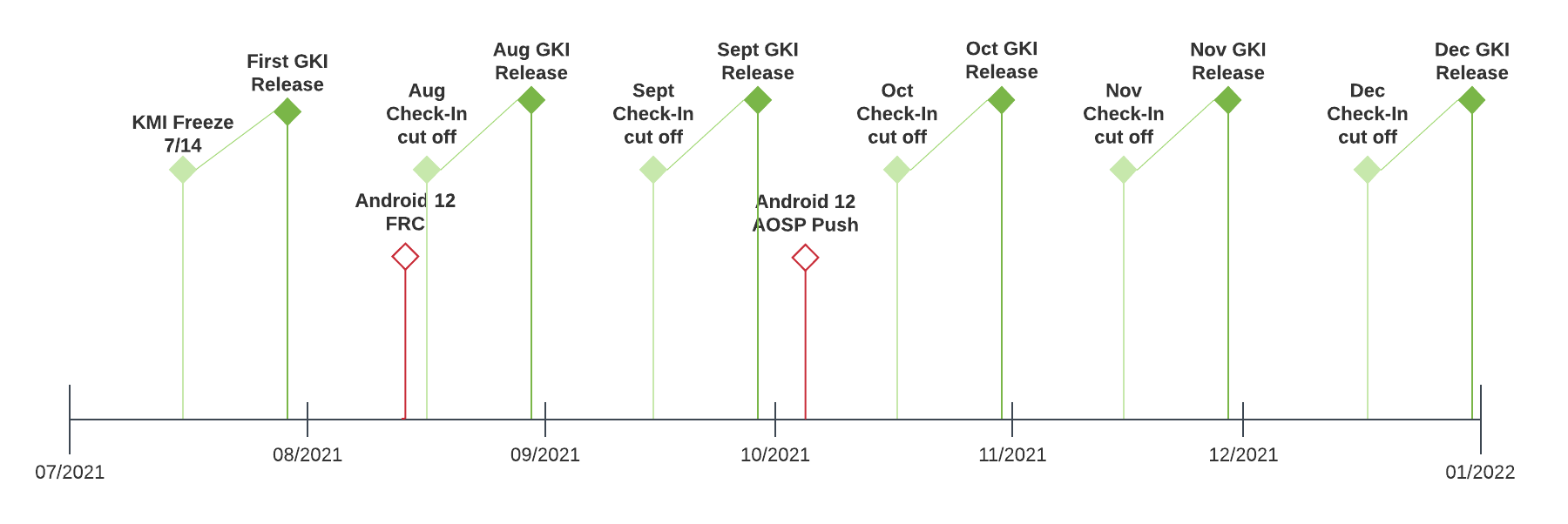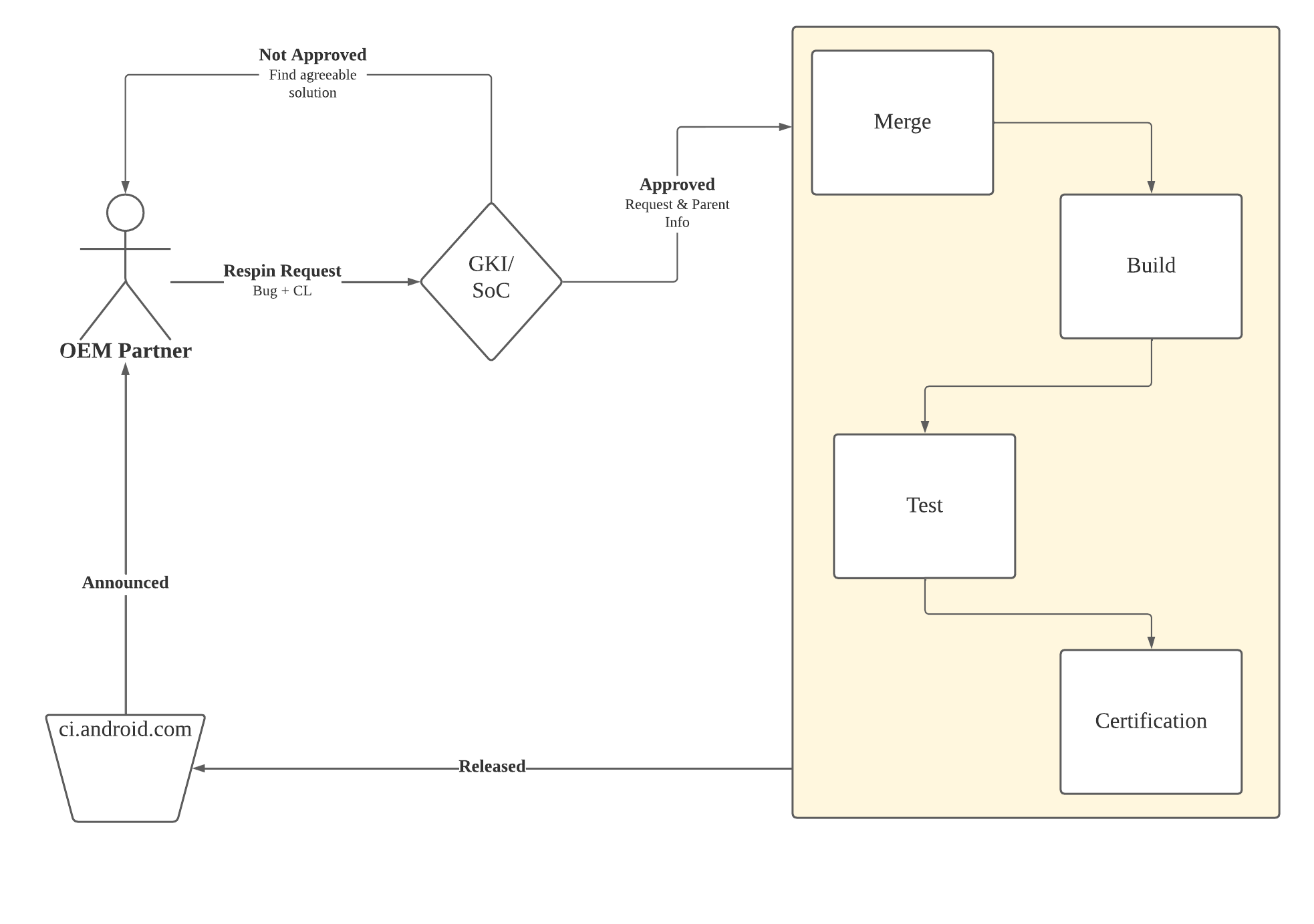This page describes how GKI is released, including weekly, quarterly, and out of band emergency releases. The goal of this document is to give OEMs a guideline on where to pick up the GKI as well as the process for out of band emergency fixes. OEMs can also use GKI development to learn more about how they can work with the Android Kernel team to optimize the GKI kernel for their products.
GKI release cadence
GKI is released on a quarterly cadence post KMI freeze.
| Release Month | a12-5.10 | a13-5.10 | a13-5.15 | a14-5.15 | a14-6.1 | a15-6.6 | a16-6.12 | a17-6.18 | |
|---|---|---|---|---|---|---|---|---|---|
| October 2025 |
Check-in cut off GKI preload ready |
Oct 16 Oct 31 |
Oct 1 Oct 15 |
Oct 1 Oct 15 |
|||||
| December 2025 |
Check-in cut off GKI preload ready |
Dec 1 Dec 15 |
Dec 1 Dec 15 |
Dec 1 Dec 15 |
Dec 1 Dec 15 |
||||
| January 2026 |
Check-in cut off GKI preload ready |
Jan 16 Jan 31 |
Jan 2 Jan 15 |
Jan 2 Jan 15 |
|||||
| March 2026 |
Check-in cut off GKI preload ready |
Mar 1 Mar 15 |
Mar 1 Mar 15 |
Mar 15 Mar 31 |
|||||
| April 2026 |
Check-in cut off GKI preload ready |
Apr 16 Apr 30 |
Apr 1 Apr 15 |
Apr 1 Apr 15 |
|||||
| June 2026 |
Check-in cut off GKI preload ready |
Jun 1 Jun 15 |
Jun 1 Jun 15 |
Jun 15 Jun 30 |
Jun 15 Jun 30 |
||||
| July 2026 |
Check-in cut off GKI preload ready |
Jul 16 Jul 31 |
Jul 1 Jul 15 |
Jul 1 Jul 15 |
|||||
| September 2026 |
Check-in cut off GKI preload ready |
Sep 1 Sep 15 |
Sep 1 Sep 15 |
Sep 16 Sep 30 |
Sep 16 Sep 30 |
||||
| October 2026 |
Check-in cut off GKI preload ready |
Oct 16 Oct 31 |
Oct 1 Oct 15 |
Oct 1 Oct 15 |
|||||
| December 2026 |
Check-in cut off GKI preload ready |
Dec 1 Dec 15 |
Dec 1 Dec 15 |
Dec 1 Dec 15 |
Dec 1 Dec 15 |
||||
GKI build validity for OEMs
OEMs can use a recently released Android GKI. OEMs can launch with GKI-certified builds as long as they are compliant with LTS requirements in the Android Security Bulletin (ASB).
Quarterly certified releases
GKI quarterly releases contain a tested boot.img that includes a Google
inserted certificate to attest that the binaries were built from a known source
code baseline.
Each quarter, a GKI quarterly release candidate (not certified) is selected after the check-in cut off date, which is usually the second weekly build of that month. After the quarterly release candidate is selected, new changes won't be accepted into that month's release. During the closed window period, only fixes for bugs that cause test failure can be addressed. The release candidate undergoes quality assurance—as described in the GKI qualification section—to ensure compliance tests pass on GSI+GKI build with a reference device as well as cuttlefish.
 Figure 1. GKI release timeline
Figure 1. GKI release timeline
Emergency respin process
A respin refers to the process of remerging, rebuilding, retesting, and recertifying a binary after a public release of the GKI kernel. You can request a respin of a certified binary for any of the following circumstances:
- To update a symbol list.
- To apply a fix to a bug, including bugs found during carrier lab approval.
- To add a vendor hook.
- To apply a patch to an existing feature.
- To apply a security patch (after 6 months).
Security patches are automatically merged into a release branch for up to 6 months after the branch's release. After the 6 month cutoff, you must request a respin to apply security patches to a branch.
Respin request guidelines
Before requesting a respin, note the following guidelines:
Respins are allowed only on release branches after an initial public release of a quarterly build has been launched.
Respin requests are accepted only for a given release branch for a maximum of six months after the initial public release. After six months, branches are eligible for respin only for security patches cited in an Android Security Bulletin.
When the LTS requirements , defined by the Android Security Bulletin (ASB) cause the branch to be noncompliant, the branch is deprecated. Respin requests for deprecated branches aren't accepted. The deprecation date for a given GKI release branch is included in the quarterly GKI release build notes under Releases. For future planning, the LTS requirements are updated in May and November annually. For example, the
android12-5.10-2023-07branch (5.10.177) isn't supported for respins after May 1, 2024, because theandroid12-5.10-2023-07branch (5.10.177) doesn't comply with the LTS requirements of ASB-2024-05.Respins are applicable only for urgent bug fixes, symbol list updates, or to apply a patch to fix an existing feature.
All patches going into the quarterly release branch must already be merged into the main GKI development branch. For example, if a patch is required for a respin of
android12-5.10-2022-09, it must already be merged intoandroid12-5.10.You must cherry-pick patches from the main GKI development branch and upload the patch to the quarterly release branch.
In the respin request, you must assign a priority (urgency) to the request. This priority helps the GKI team to better assist partners in a timely manner. For critical or time-sensitive requests, mark priority as P0. For P0 and P1 requests, you must also justify the urgency. The following table provides a mapping of bug priority and time to resolution (ESRT):
Priority ESRT P0 2 business days P1 5 business days P2 10 business days P3 15 business days
You must submit a separate respin request per release branch. For example, if a respin is needed for both
android12-5.10-2022-08andandroid12-5.10-2022-09, you must create two respin requests.After a build is provided and a respin request is marked as fixed, you shouldn't reopen the respin request to add additional CLs. You must submit a new respin request if there are additional patches that need to be merged.
For each CL under consideration, add the following tags.
Bug: the bug ID must be added to the commit message for each CL.Change-Id: must be identical to the Change-Id of the base branch change.
If a respin request requires your response, and you don't respond within three business days, the priority is downgraded by one level (for example, P0 is downgraded to P1). If you don't respond for two weeks, the bug is marked as Won't Fix (Obsolete).
Submit a respin request
The following diagram shows the respin process. The process begins when the OEM Partner (you) submits the respin request.
 Figure 2. The respin process
Figure 2. The respin process
To enter into the respin process:
- Fill out the GKI Respin request form.
and reach out to your Google Technical Account Manager immediately. This form
creates a GKI respin request bug. Respin request bugs are visible to you
(the requester), the GKI team, and specific individuals that you add to the
bug's CC list.
- If you already have a fix, the request should point to the patch submittal in AOSP so Google can review it. If submitting the patch isn't feasible, the patch must be attached as a text file to the request.
- If you don't have a fix, the request must contain as much information as possible, including kernel version number and logs, so Google can help debug the issue.
- The Google GKI team reviews the request and approves it or assigns it back to you if more information is needed.
- After a fix is agreed upon, the Google GKI team code reviews (CR+2) the change. The review begins the ESRT timeframe. The GKI team merges, builds, tests for regression, and certifies the change.
- The binary is released to ci.android.com. The ESRT timeframe ends and the Google GKI team marks the request as fixed and reference the respin build. The respin build is also be posted on the Generic Kernel Image (GKI) release builds page.
GKI qualifications
| Types of GKI builds | Quality enforcement | Notes |
|---|---|---|
| Weekly | Cuttlefish testing
|
|
| Quarterly (certified) | Cuttlefish testing
|
|
| Respins (certified) | Cuttlefish testing
|
|
Where to obtain build artifacts
Artifacts for all the releases can be obtained from ci.android.com.
You can find more information on the CI, including the test results on the Android Continuous Integration dashboard.
FAQs
Here are some frequently asked questions related to the GKI release process.
Is it possible to build a new GKI binary based on an already released GKI?
Yes, this is known as a respin. The respin process is supported as long as the released GKI build (on which the respin is requested) is compliant with LTS requirements in the Android Security Bulletin (ASB).
Is it possible to reproduce GKI binaries?
Yes, here's an example:
GKI 2.0
5.10 kernel prebuilts from build 7364300
https://ci.android.com/builds/submitted/7364300/kernel_aarch64/latest
To reproduce the example, download manifest_$id.xml and execute the following
command:
repo init -u https://android.googlesource.com/kernel/manifestmv manifest_7364300.xml .repo/manifestsrepo init -m manifest_7364300.xml --depth=1repo sync # build the GKI images # You may want to use LTO=thin to build faster for developmentBUILD_CONFIG=common/build.config.gki.aarch64 build/build.sh # (optional) build virtual platform modulesBUILD_CONFIG=common-modules/virtual-device/build.config.virtual_device.aarch64 build/build.sh
You can retrieve your GKI artifact copy from out/.../dist.
Has the GKI binary (including the emergency spin patch) been built on the latest codebase?
No. Respins only contain patches that are on top of the quarterly certified kernels that have been chosen. These respins contain all launch blocking bug fixes reported until any given time by OEMs using the corresponding base quarterly release. See the following example of how this type of scenario happens.
- OEM1 and OEM2 decide to use the GKI binary release from November 2021.
- OEM1 and OEM2 find issues that require patches for support. These patches may be different or may be the same.
- The respins over top of the November 2021 binary have launch blocking fixes reported by both OEM1 and OEM2 during the respin window, but nothing more.
- The issues mentioned in the second bullet are also included in subsequent GKI quarterly releases.
The October respin has all OEM submitted patches, but other OEM patches affect us, because they haven't been specifically tested with our products. Is it possible to only include our patch?
This isn't possible. A "per-OEM" respin path isn't scalable. Instead, the GKI team scrutinizes every single change that goes into respin builds, and tests the changes with all available hardware before creating a new build. If the GKI team finds that the issue is specific to an OEM, device, or model, the GKI team can ensure that the code added by the change only executes on the device, model, or SKU being affected.
The major benefit from unified respins is that every device that's using the same release base benefits from one another, especially if the bugs they discover are generic and applicable to all users. Core kernel bugs found in carrier testing is a specific example of this concept.
Are there situations where Google provides specific information about OEM patches and issue scenarios, so that OEMs can evaluate the impact and risk of implementing the patches with their products?
Google won't ever add a change to a respin build until the problem is understood and all of the details have been collected. This is seen in the changelog (commit message). Google does not reveal what specific device it affects, but OEMs can always find the issue description and solution in the changelog.
